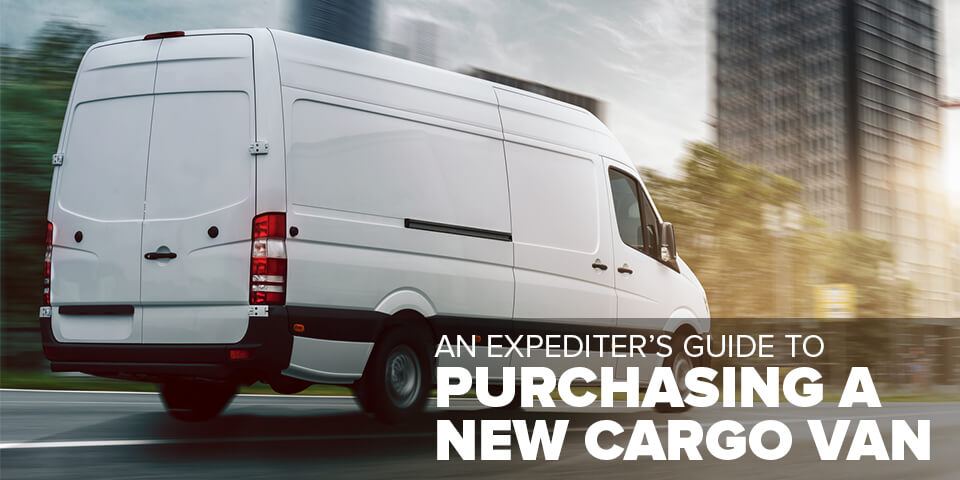
If you're not ready to invest $200,000 in a new straight truck to become an expedite owner-operator, perhaps a cargo van is a more practical starting point.
But with numerous van options and configurations available, what should you consider in a van for expediting? Use this seven-point checklist as a guide.
#1. Carrier requirements
What van specifications does your trucking carrier require? Get the answer to this question before you begin van shopping. Otherwise, you take the risk of making a substantial investment in a van that won?t be acceptable to the carrier you plan to lease with.
Also, if you?re new to expediting, why try to reinvent the wheel with cargo van specs for expedited freight? Instead, lean on the carrier?s expertise to help point you in the right direction.
#2. Euro-style vs. conventional-style
The Mercedes-Benz/ Freightliner Sprinter has been the most prominent van used in expedite applications for nearly two decades. It was the first diesel-powered Euro-style van to enter the U.S. market, offering multiple roof height configurations, which maximize cargo space and enable drivers to stand up inside the cargo area.
And in recent years, other automakers have introduced Euro-style vans to the U.S. market, including Ford (with Transit) and Ram (with ProMaster), giving expediters more van options to choose from.
GM?s Chevrolet Express and GMC Savana are the remaining conventional-style van models with one roof configuration at standard height.
#3. Payload capacity
Payload capacity refers to the maximum weight the vehicle can safely carry after subtracting the weight of the vehicle itself and its occupants.
So, how much payload capacity do you need? In other words, how much cargo weight must the van be able to haul at full load?
Your answer to this question determines which model/ class van to choose. For example, most expedite vans are either three-quarter-ton (Sprinter/ Promaster 2500 or Transit 250) or one-ton (Sprinter/ Promaster 3500 or Transit 350) models.
#4. Cargo area
How much space does your cargo take up on a full load? This helps you select the right length and roof height configuration for the job.
That?s because, with most manufacturers, you have two to three length/ wheel base options to choose from?regular, extended and long. And with the Euro-style vans like the Sprinter, Ford Transit and Ram Promaster, there are also multiple roof heights to consider depending on your cargo area requirements.
But you?ll also need to think about the impact of dual-rear wheel vs. single-rear wheel configurations on cargo space.
For example, if you?re looking at a Sprinter to haul pallets of, say, auto parts, you would select the single-rear wheel 2500 van, instead of a dual rear wheel 3500, because the wheel wells in the 2500 take up less space than those in the 3500.
However, the trade-off with selecting a Sprinter 2500 vs. the dual-rear wheel 3500 is about 2,000 pounds in legal payload capacity. So, make sure the weight of your anticipated maximum loads will fit within the capacity of the van you select.
#5. Engine
If you?re interested in a diesel engine, this limits your options to the Sprinter and the GM vans which offer both gas and diesel engine options.
Ram offers one gas engine?the 3.6 liter V-6. And Ford has two gas engines?a 3.5 liter standard V-6 and the 3.5 liter EcoBoost V-6, which offers higher fuel-efficiency for about $1,500 extra.
#6. Rear-axle ratio
The Ford Transit, for example, now offers axle ratios of 3:31, 3:73 and 4:10.
But what does ?rear-axle ratio? really mean in practical, performance terms?
Here?s the typical rule of thumb. The higher the numerical ratio, the slower the gear will be. This higher ratio gives your truck greater pulling power, but since the engine must work harder to spin the driveshaft more times for each turn of the rear wheels, you sacrifice top-end speed and fuel economy.
The inverse also holds true. When you lower the numerical ratio, you increase available top-end speed. And since the engine doesn?t have to work as hard to turn the wheels faster, fuel economy improves. The downside is that pulling power diminishes.
So, when selecting the right axle ratio for your application, use these general guidelines to help point you in the right direction:
- High numerical ratios. This is for maximum towing and payloads and on hilly terrain with steep grades.
- Mid-range numerical ratios. Spec this ratio when the truck requires flexibility for operating on varied terrain with moderate towing and payloads.
- Low numerical ratios. This makes sense for flat terrain, lighter loads, and running at consistent highway speeds.
#7. Comfort & Safety Systems
Rear view cameras are now standard on all van models. And the manufacturers have added numerous available comfort and safety options in recent years, such as:
- Adaptive cruise control
- Pre-collision assist with automatic emergency braking
- Parking assist
- Backup alarms
- Blind spot detection
- Bluetooth enabled radio to allow for hands-free calling
- Suspension seating
- Extra lumbar support.
The key point here is to evaluate and determine which comfort and safety systems best fit your needs and budget.
